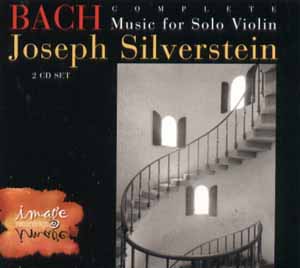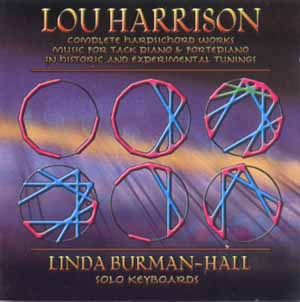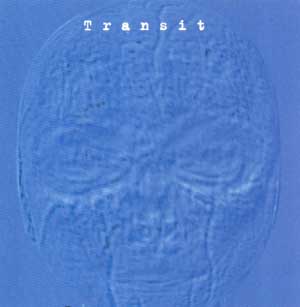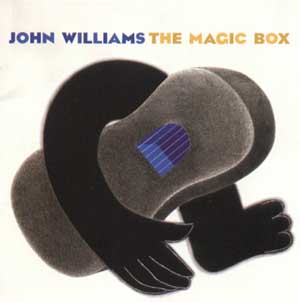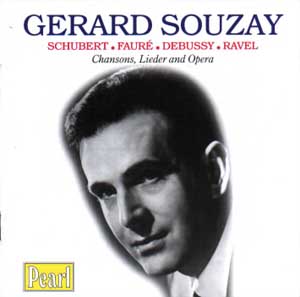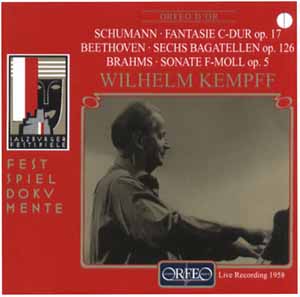|

BACH: MUSIC FOR SOLO VIOLIN - JOSEPH SILVERSTEIN - IMAGE RECORDINGS IRC
0201
To celebrate his 70th birthday, Joseph Silverstein, Principal Guest Conductor
of Seattle's Northwest Chamber Orchestra, as well as Conductor Laureate of the
Utah Symphony and member of the Chamber Music Society of Lincoln Center, has
recorded Bach's complete music for solo violin. Consisting of three Sonatas
and three Partitas, these compositions, along with Bach's six solo cello
suites, rank among Bach's greatest masterpieces.
While Silverstein's technical assurance is never in question, his playing
frequently pales when compared to recordings from other artists. Partly this
is due to the recording itself, whose lack of air, color and life further
sabotages playing that does not consistently engage. A case in point is the
famed Partita No. 2 in D minor, which has recently been celebrated in the
chart-toppingMorimur recording from violinist Christoph Poppen and the
Hilliard Ensemble (ECM). Silverstein may play a prized Guarneri del Jesu
violin so cleanly that not a squeak can be heard - Poppen squeaks like crazy,
and lacks Silverstein's technical perfection -- but Silverstein's opening
dance movement "Allemande" feels leaden when compared to Poppen's.
Silverstein's playing pales when put up against Arthur Grumiaux's famed,
mostly faster 1961 recording (Philips Duo). Even when Silverstein almost
equals Grumiaux's speed in the third movement "Sarabande," it is Grumiaux who
expresses Bach's dance rhythms to perfection; his far more substantial playing
is also more pointed and incisive, with greater dynamic range, color and tempo
variation.
It is difficult to conclusively judge Poppen's playing, because some of his
tempi - his second movement "Corrente" and fourth movement "Gigue" are slower
than anyone else's -- seem dictated by the choral/solo violin juxtaposition of
the Morimur project. His final "Chaconne," however, with a tempo midway
between Silverstein zippy 12:41 and Hahn's drawn out 17:47, includes a
triumphant passage that makes it all worthwhile.
The 17-year old Hilary Hahn (Sony) takes a far more romantic approach than
these other violinists, with the opening Allemande and concluding Chaconne
played notably slower than anyone else's. While these movements barely sound
like dances, Hahn's her use of vibrato, alteration of dynamics, and
exceptional fluid singing tone are so heartfelt that one cannot help but fall
in love with her playing. Ultimately, it is to Grumiaux and Hahn that many
will wish to return.

LOU HARRISON - KEYBOARD WORKS - LINDA BURMAN-HALL, SOLO KEYBOARDS - NEW
ALBION 117
What a great birthday tribute. As 85 year old Lou Harrison enters yet another
productive phase of his remarkable composing career, San Francisco's
adventurous New Albion Records gifts him and all with this generous
compilation of Harrison's unusual keyboard works.
Ever the political and musical maverick, Harrison joins his fellow composer,
the late Harry Partch, in writing keyboard music that intentionally eschews
"traditional" twelve-tone tuning. As Harrison explains in the liner notes,
"Although for several centuries keyboards were made that presented more than
twelve tones, the hypnosis of twelve has continued, and continues to spread
wherever "Western" culture settles in Linda and I have become part of [the]
apostasy from the dull gray of industrial twelve tone equal temperament and
worked together to take back to ourselves as artists the natural right to tune
pieces in ways that are fitting, appropriate, or enhance musical beauty."
The determined team of Harrison and Linda Burman-Hall present their generous
helping of keyboard works on a variety of harpsichords, as well as on tack
piano (which uses thumbtacks in the hammers to create a sound similar to the
harpsichord) and fortepiano. Pitches and tunings vary. The result is a strange
sonic universe, whose unusual relationships between notes leave listeners
without the usual tonal anchors that enable one to find home. Although for
some the experience may summon forth feelings of being lost at sea, for others
the adventure reveals new tonal landscapes formerly obscured by twelve-tone
hegemony.
The disc opens with a piece written expressly for Burman-Hall, the Sonata for
Harpsichord (1999), played on a French double harpsichord. Composed of three
contrasting movements based on modal scales, the work offers Harrison's usual
exuberance, but with harmonics equally strange and captivating. The same can
be said forVillage Music, a recent compilation drawn from works written
between 1941 and 1989, and played on a Spanish single-manual harpsichord with
an "occasional" tuning created just for the occasion.
Drawing upon the gestures, textures and forms of traditional Spanish music,
Six Sonatas for Cembalo (1943) is tuned in Baroque well-temperament and played
on French double harpsichord.Incidental Music for Corneille's Cinna (1957),
played on tack piano, employs tuning which pulls the rug out from under the
so-called "totalitarian tonal regime" of equal temperament (which
Burman-Hall
suggests frequently masquerades as democracy).
On the lighter side, Harrison describes his final "Round" from A Summerfield
Set (1988), which he dedicated to the Summerfield family's recently born son,
as "appropriately a bit childish." One of the Three Earlier Works for Solo
Keyboard, "A Twelve-Tone Morning After to Amuse Henry" (ca. 1944-1945), was
presented as an impromptu musical jest to Henry Cowell, Harrison's mentor,
friend, neighbor, and fellow maverick musician.

JOHN FITZ ROGERS - TRANSIT - MICHAEL NICOLELLA, ELECTRIC GUITAR - GALE 02-003
One thing is for certain: this recording will engender strong reactions. Some
will agree with the liner notes' pretentious prose, which suggests that this
collaboration between Rogers and Nicolella provides "an electrifying sonic
network of speed and synthesis, a forty-four minute panorama of intangible
miracles." Others will find themselves screaming at Transit's dizzying drive,
at such sections as the three and a half minute "V," which begins with
programmed sounds resembling a recording sped up half way to infinity, only to
end with Nicolella's electric guitar further hammering the point home.
In Transit, composer Fitz Rogers, showing the influence of Led Zeppelin, the
Steve Miller Band, and Jim Hendrix, weds his computer-generated organs,
pianos, drums and array of fantastic sounds to the astounding musicianship of
his chosen collaborator, guitarist Michael Nicolella. Playing three guitars, a
1998 Fender Stratocaster, 1979 Gibson Les Paul Custom, and 1954 Guild X-150
archtop, allied with various amplifiers and stompboxes, the Seattle-based
Nicolella is a virtuoso wonder.
Transit begins slowly, with several minutes of quasi-celestial
computer-generated sounds. Once the guitar enters, however, the mood changes,
as the conflict and chaos of earthbound existence rise to the fore. The work
is studded with frequently stunning juxtapositions, its unapologetic
commentary destined to either enrapture or force one to run for cover while
invoking the names of Bach, Mozart and the entire Hindu panoply.
In many ways, Transit seems an appropriate commentary on life in the 21st
century. After all, in a world where Easter night channel surfing takes you
from Charlton Heston's Moses proclaiming God's commandment, "Thou Shalt Not
Kill," to fresh footage of Israeli politicians screaming for vengeance; where
George Bush, who stole the Presidency, condemns Fidel Castro for not holding
free elections, far more than hard driving irony and Strauss waltzes are in
order.
Parts of this virtual symphony seem ecstatic, others funereal. Its pace and
multi-layered chaos will either energize you or give you a headache. Either
way, or both, it must be heard.

JOHN WILLIAMS - THE MAGIC BOX - SONY SK 89483
This well-recorded, natural sounding disc presents one of the West's foremost
guitarists playing pretty music related to Africa, Cape Verde Island and
Madagascar. Joined on various tracks by the African Children's Choir, three
Caucasian musicians, and Cameroon-born Frances Bebey, guitarist/composer John
Williams offers a "magic box" assortment of fifteen well-recorded, major keys
lovelies.
Although one rarely associates the guitar with the music of Africa, the
instrument was first introduced to the continent and its islands by the
Portuguese in the fifteenth century. However, because Africa already had an
indigenous assortment of unique string instruments which created sounds more
central to its culture, it was only in the 20th century, as Western cultural
influence followed Christian missionaries into the heartland, that the guitar
began to assert itself in African popular and traditional music. Indeed,
Williams' instrument's very timbre seems light years removed from the drums
and chants that we associate with traditional tribal rituals.
Williams, who arranged all but two of the tracks, composed several selections,
mostly based on traditional songs. Five pieces including the title track are
by Bebey, who plays and sings his new piece "Engome." One cut is by Jean
'Bosco" Mwenda, originally from Zaire; two are by Paul-Bert "Rossy'
Rahasimanana,
composed for a documentary film on Madagascar.
At the risk of sounding like the grinch who stole Christmas, this disc offers
confections so sweet as to seem far removed from present-day realities.
Indeed, at its crossover nadir, when the African Children's Choir adds its
voice to John Williams' homogenized guitar and panpipe arrangement of "Nkosi
Sikelel'i Afrika," the anthem of the African National Congress that derives
from a Christian hymn, images surface of perpetually smiling darkies tap
dancing their way through Hollywood while the Klan marched through the
Carolinas. Listening to this music, one would never know that the African
continent is ravaged by AIDS, that millions are dying of starvation, and that
the red soil of Madagascar has become so over-farmed and eroded that, seen
from on high, the former Paradise looks like it is bleeding into the sea.
Lovely as background music for din din, too cream-filled for a major course.

GERARD SOUZAY - CHANSONS, LIEDER AND OPERA -- PEARL GEM 0159
Born in 1918, baritone Gerard Souzay graced the recital stage for over 40
years. This indispensable disc reissues his first lp recordings from 1950,
performances that helped him gain prominence as the premiere interpreter of
French chanson of his generation.
Although Souzay appeared in opera, the first selection, a monotoned reading of
Handel's aria "Si, tra I ceppi" (Berenice), leaves no question that art song
offered him greater opportunities to utilize his many gifts. The next track,
Beethoven's great lied (song) "In questa tomba oscura," shows him at his best.
Filled with light and shadow, the plethora of soft tones perfectly supported
by the breath, the degree of subtle dynamic variation and shading, and, most
importantly, the singer's total emotional involvement give life to the plea of
the departed soul who begs for peace from within the grave.
Souzay's sense of total immersion is palpable in his recordings of ten Fauré
chanson (including the four L'Horizon Chimérique). Recorded with accompanist
Jacqueline Bonneau, these performances are as idiomatically and emotionally
perfect as some of the Fauré interpretations by soprano Maggie Teyte, whose
career was winding down just as Souzay's was gaining momentum.
The disc also includes treasurable performances of three Debussy chanson,
three songs from Ravel's Don Quichotte à Dulcinée, and six lied by Schubert.
Later on, Souzay recorded stereo versions of the Ravel, some of the Fauré, and
Schubert's "Der "Doppelgänger," "Heidenröslein," and "Erlkönig," but these
monaural recordings find him in freshest and sweetest voice. Every lover of
the song repertoire who does not own the original LPs will want this disc.

|
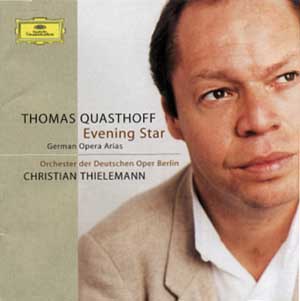 |
|
|
0 |
5 |
|
Performance |
 |
|
Sonics |
 |
|
|
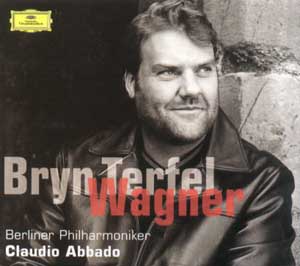 |
|
|
|
0 |
5 |
|
Performance |
 |
|
Sonics |
 |
|
|
THOMAS QUASTHOFF - EVENING STAR: GERMAN OPERA ARIAS - DG 289 471 493-2
BRYN TERFEL - WAGNER - DG 289 471 348-2
If you've attended one of 43-year old German bass-baritone Quasthoff's Bay
Area appearances, you know the beauty of his voice and the extent of his
interpretive mastery. His 37-year old Welch bass-baritone contemporary Bryn
Terfel, who most recently presented a Cal Performances recital, possesses a
larger voice: round, powerful, luscious, and capable of darker but equally
seductive sounds.
The differences in the way these men use their voices is as great as the
physical contrast between the two - Quasthoff, whose mother took the harmful
fertility drug Thalidomide, is way under 5 feet, and moves awkwardly, while
Terfel is a towering bear of a man who seems to have moved beyond his back
problems. Terfel tends to rely heavily on word painting, sometimes laying it
on too thick; Quasthoff eschews over-interpretation, combining economy of
expression with a marvelous mastery of summoning the right tone and energy to
express the emotion at hand. Expressed differently, Terfel can seem to color
words from the outside, while Quasthoff's palette seems a natural extension of
his inner sensibilities.
In these discs of operatic arias, the contrast between Quasthoff and Terfel
becomes apparent in the one selection they share in common, Wolfram's "Wie
Todesahnung Dämmrung deckt die Lande (The Song to the Evening Star)" from
Wagner's Tannhäuser. Given ideally transparent and expressive support by
conductor Christian Thielemann and the Orchester der Deutschen Oper Berlin,
Quasthoff delivers a rapt performance, sounding transported as he prays to the
Evening Star to help guide a departed soul on its flight from earth to heaven.
Terfel, receiving less-than-poetic support from Claudio Abbado and the
Berliner Philharmoniker, sounds too occupied with underscoring the meaning of
every word to fully embrace the essence of heavenly transcendence. Even though
it is Terfel who seems more equipped to meet Wagner's vocal demands, it is
Quasthoff who convinces.
Despite a voice in prime health, Terfel disappoints through most of his
recital; the man sounds as though he has yet to find his way into the heart of
Wagnerian conflict and passion. Comparisons with his recording of "Die Frist
ist um" from Der Fliegende Holländer reveal a far more crushing sense of
tragedy in the gorgeously voiced 1937 live performance of Herbert Janssen
(with Reiner), and more convincing drama from James Morris (far more
satisfyingly conducted by James Levine). And when heard alongside the classic
Hans Hotter/Georg Solti recording of Wotan's "Leb wohl, du kühnes, herrliches
Kind!" from Die Walküre, the Terfel/Abbado partnership seems to merely skim
the surface.
Terfel has been quite cautious in adding Wagner to his repertoire; he first
sang Wolfram in 1997, and will not tackle the role of Hans Sachs in Die
Meistersinger before 2003. Given that Janssen's voice rapidly declined after
the Met forced him into heavy Wagnerian roles, and Hotter and Morris were both
sounding worn at the time of their respective recordings, Terfel's reluctance
is more than justified. Let us hope that he continues to devote his resources
to repertoire more suited to his voice and temperament.
Lest you think that Quasthoff lacks personality, by all means listen to his
buoyant interpretations of multiple roles from Lortzing'sZar und Zimmermann
and Der Wildschütz. Quasthoff , who offers plenty of outspoken character
during his recitals, knows how to channel his gifts in service to operatic
interpretation. This is a wonderful disc, with singing that will serve as a
model for years to come.

SCHUMANN * BEETHOVEN * BRAHMS - WILHELM KEMPFF, PIANO - ORFEO C 570 011 B
Some artists perform music; others present us with entire universes, taking us
on mental, emotional, and spiritual journeys far removed from the level of
mechanical reproduction or technical perfection. Wilhelm Kempff is such an
artist.
This priceless, sometimes hard to find disc, available from
http://www.qualiton.com,
features the great pianist in his sole live Salzburg Festival concert, held in
the Mozarteum in Salzburg, Austria on July 31, 1958. While the first
selection, Robert Schumann's Fantasie in C Major, Op. 17, was recorded by
Kempff commercially, the other two pieces, Ludwig von Beethoven's Six
Bagatelles, Op. 126 and Johannes Brahms' Sonata in F, Op. 5, were not captured
in the studio. Thus the disc holds inestimable historic value, offering us our
only opportunity to hear Kempff perform two works central to his career.
Recorded when the pianist was 63 and at the height of his powers, what the
mono recording lacks in midrange richness it more than delivers in poetic
interpretation.
Kempff was schooled in the 19th century tradition, a method of interpretation
that allowed for far more poetic license, rubato, and shading than is normally
encountered on today's stages. The man was born when enough of the environment
that spawned these compositions was still intact to enable him to understand
these works on the deepest levels. As a result, his core romantic repertoire -
Beethoven, Schubert, Schumann, and Brahms - sings with a heartfelt truth that
makes it highly prized.
Thankfully, Austria was blessed with several critics who witnessed this
performance and the effect it had on the audience. Here is the assessment of
Otto Sertl, as recorded in the Salzburger Nachrichten on August 2, 1958:
"In our age, which is apparently so averse to all romanticism, [Kempff] cares
for the miraculous blossoms of German piano poetry without the slightest
concession to any new objectivity - and with that, brings practically any
audience unconditionally under his spell. Schumann's perhaps richest piano
work, his Op. 17, originally bore the somewhat mysterious title of "Obulus"
with the three sub-headings "Ruins - Triumphal Arch - Constellation" before it
was renamed "Fantasy" by Schumann himself. In Wilhelm Kempff's hands, the
gushing passion of these Romantic visions sounds wildly demonic, its idyllic
final song most tenderly poetic.
Kempff grabs his audience even more directly in that high-Romantic showpiece,
the Sonata, Op. 5 of Johannes Brahms. Brahms hardly knew, at the time, how to
contain the abundance of his thoughts in the repeatedly interrupted form of
the sonata. The young man wrote his "Song of Love and Death" with his life's
blood, the blood of his so often veiled heart, with powerfully masculine yet
almost always dark, wistful notes. The German pianist, today over sixty,
became twenty again with this work. He does not know the slightest hesitant
consideration whilst facing the dangers of the first movement's chord
agglomerations or the demonic Waltz-Scherzo's arpeggios, and stretches the
backward-glancing Intermezzo's pianissimo to a hardly audible trace."
-
Jason Serinus -

Terms and Conditions of Use

|

